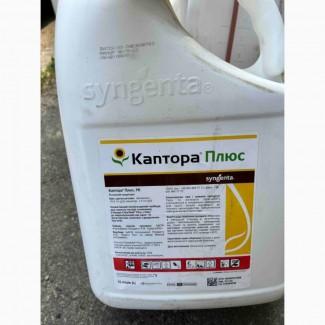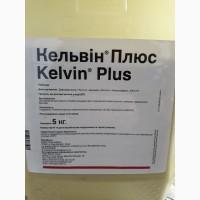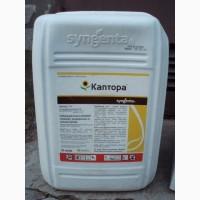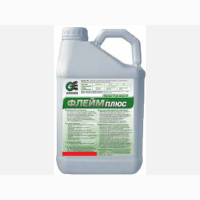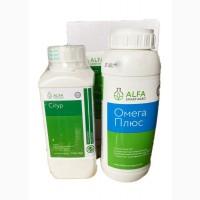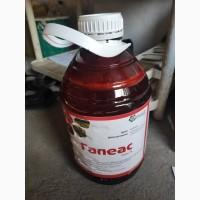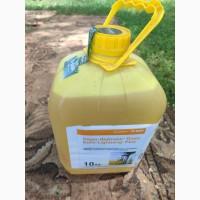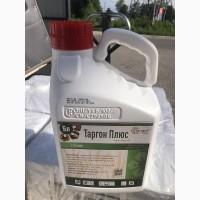/ Fertilizers and plant protection products / Herbicides / Kaptora plus - an effective herbicide for controlling...
Sell / buy
Kaptora plus - an effective herbicide for controlling weeds in sunflower crops, Kyivska region.
Price16.5$
Region:all of Ukraine,
Kyiv region.
(Vyshhorodok)
Updated:
Captora Plus herbicide is recommended for use onsunflower hybrids of the production Clearfield Plus system and AIR sunflower hybrids to control a complex of grass and dicotyledonous weeds. In areas where the infection is widespread, it is one of the key elements of the complex sunflower protection system.
The content of the active substance:
imazamox, 16.5 g/l + imazapyr, 7.5 g/l
Preparative form: soluble concentrate
Mode of action: systemic with residual soil activity
Consumption rate: 1.6-2.5 l/ha
The consumption rate of the working solution: 200-400 l/ha
Packaging: 10 liters, the price is for 1 liter.
Advantages of Captor Plus Herbicide:
reliable protection against infection and weeds;
enhanced control of thistles, ragweed, ragwort and grass weeds;
wide window of application (from the 2nd to the 8th sheet);
control of subsequent waves of weeds (ground action);
allowed for use on AIR sunflower hybrids ;
the possibility of using it in systems with energy-saving soil cultivation technology.
Application of Kaptor Plus Herbicide:
Sunflower (production system Clearfield Plus and AIR hybrids)
Consumption rate - 1.6-2.5 l/ha
Spectrum of action - Monocotyledonous and dicotyledonous weeds.
Time of application - Spraying crops in the phase from 2 to 8 true leaves in the culture (at the initial stages of weed development)
The number of treatments is 1.
The mechanism of action of Captor Plus Herbicide:
The effect of the drug is manifested within an hour after treatment - the synthesis of essential amino acids is blocked, which leads to the cessation of growth of sensitive plants.
The effect of the herbicide persists for 3-4 weeks after application and depends on weather conditions.
Recommendations for the use of Captor Plus Herbicide:
Kaptor Plus should be used exclusively on sunflower hybrids intended for the Clearfield Plus production system;
it is most effective to apply when most weeds are in the initial stages of development;
application temperature: from +14 ° C to +25 ° C;
rate of herbicide use:
1.6 l/ha - one-year dicots up to 2 leaves;
2.0 l/ha - one-year dicots (2-4 leaves), incl. ragweed, white marigold, common sedge, annual grasses and sedges;
2.5 l/ha – annual overgrown, perennial dicots (thistles, birch) up to 6 leaves in weeds;
stages of culture:
2-4 leaves in the culture - annual grasses, annual and perennial dicotyledonous weeds, weeds;
6-8 leaves in the culture - sometimes in the case of late sowing or late appearance of infection (all races);
requires uniform application over the entire area (overlappingsprayer passages must be minimized).
Precautions for the use of Kaptor Plus Herbicide:(//tractor-service.com)
do not violate the temperature regime during application and do not apply herbicide when sunflower plants are in a state of stress under the influence of abiotic factors (low or, conversely, high temperatures, excessive soil moisture, etc.);
it is not allowed to carry the working fluid to the neighboring fields.
Proven tank mixes of Captor Plus Herbicide:
Application in tank mixtures with other herbicides is not advisable (highly effective drug). The drug can be used in tank mixtures with many other means of protection, but before use it is necessary to check the compatibility of the drugs.
Captora is an effective herbicide for weed control in Clearfield sunflower crops
Active substance - 33 g/l imazamox 15 g/l imazapyr
Culture - Sunflower Clearfield
Weeds - Annual dicots and grasses
Type - Post-emergence
The form of the drug - Aqueous concentrate
Container - 20 liters, the price is indicated for 1 liter.
Features of Kaptor herbicide
The Kaptora drug is produced in the form of a soluble aqueous concentrate packaged in twenty-liter plastic canisters.
It belongs to the inorganic type of herbicides with selective (selective) action.
Features of the use of Kaptor herbicide
Processing is carried out once at the growth stage of the fourth or fifth sunflower leaf and the second or third weed leaf.
The active ingredients of the herbicide create a "protective screen" on the soil, which will prevent new weed sprouts from sprouting for two months.
The use of the drug Kaptora is not recommended in stressful conditions of seedlings (temperature changes, drought, rains).
The optimal air temperature during crop processing is 12-25°C.
The herbicide can be used on one field no more than once in three years. At the same time, the sowing scheme should look like this:
• cultures resistant to the action of imidazolinones - without restrictions;
• rye and wheat - after four months;
• legumes, cereals (rice,corn, barley, sorghum and so on) - after nine months;
• potatoes and other vegetables - after a year and a half;
• buckwheat, rapeseed, millet, fodder and sugar beet - after two years.
In some cases, in the first days after using the drug Kaptora, a change in the color of the leaves or the height of the shoots may be observed. Usually, it goes away on its own within two weeks.
Instructions for the use of Kaptor herbicide
The consumption rate of Kaptor per one hectare of land is 1-1.2 l,
The total volume of working fluid per hectare is 200-400 liters.
The solution must be prepared immediately before processing:
• fill the container for the working solution by 1/3 with water;
• add the required amount of concentrate, mix thoroughly;
• add water to the full volume.
Irrigation should be carried out in dry, windless weather in the morning or evening.
During two weeks after spraying, it is not recommended to carry out mechanical processing of the land between the rows to avoid the germination of weeds from perennial rhizomes.
Due to the fact that Kaptor herbicide belongs to the third class of toxicity, it cannot be mixed with other herbicides, liquid mineral fertilizers and means for destroying harmful insects.
Important information!
Conventional varieties of sunflower and most agricultural crops are not recommended to be treated with Kaptor herbicide: this can lead to inhibition of growth and subsequent death. Use only for the specified sunflower varieties!
The content of the active substance:
imazamox, 16.5 g/l + imazapyr, 7.5 g/l
Preparative form: soluble concentrate
Mode of action: systemic with residual soil activity
Consumption rate: 1.6-2.5 l/ha
The consumption rate of the working solution: 200-400 l/ha
Packaging: 10 liters, the price is for 1 liter.
Advantages of Captor Plus Herbicide:
reliable protection against infection and weeds;
enhanced control of thistles, ragweed, ragwort and grass weeds;
wide window of application (from the 2nd to the 8th sheet);
control of subsequent waves of weeds (ground action);
allowed for use on AIR sunflower hybrids ;
the possibility of using it in systems with energy-saving soil cultivation technology.
Application of Kaptor Plus Herbicide:
Sunflower (production system Clearfield Plus and AIR hybrids)
Consumption rate - 1.6-2.5 l/ha
Spectrum of action - Monocotyledonous and dicotyledonous weeds.
Time of application - Spraying crops in the phase from 2 to 8 true leaves in the culture (at the initial stages of weed development)
The number of treatments is 1.
The mechanism of action of Captor Plus Herbicide:
The effect of the drug is manifested within an hour after treatment - the synthesis of essential amino acids is blocked, which leads to the cessation of growth of sensitive plants.
The effect of the herbicide persists for 3-4 weeks after application and depends on weather conditions.
Recommendations for the use of Captor Plus Herbicide:
Kaptor Plus should be used exclusively on sunflower hybrids intended for the Clearfield Plus production system;
it is most effective to apply when most weeds are in the initial stages of development;
application temperature: from +14 ° C to +25 ° C;
rate of herbicide use:
1.6 l/ha - one-year dicots up to 2 leaves;
2.0 l/ha - one-year dicots (2-4 leaves), incl. ragweed, white marigold, common sedge, annual grasses and sedges;
2.5 l/ha – annual overgrown, perennial dicots (thistles, birch) up to 6 leaves in weeds;
stages of culture:
2-4 leaves in the culture - annual grasses, annual and perennial dicotyledonous weeds, weeds;
6-8 leaves in the culture - sometimes in the case of late sowing or late appearance of infection (all races);
requires uniform application over the entire area (overlappingsprayer passages must be minimized).
Precautions for the use of Kaptor Plus Herbicide:(//tractor-service.com)
do not violate the temperature regime during application and do not apply herbicide when sunflower plants are in a state of stress under the influence of abiotic factors (low or, conversely, high temperatures, excessive soil moisture, etc.);
it is not allowed to carry the working fluid to the neighboring fields.
Proven tank mixes of Captor Plus Herbicide:
Application in tank mixtures with other herbicides is not advisable (highly effective drug). The drug can be used in tank mixtures with many other means of protection, but before use it is necessary to check the compatibility of the drugs.
Captora is an effective herbicide for weed control in Clearfield sunflower crops
Active substance - 33 g/l imazamox 15 g/l imazapyr
Culture - Sunflower Clearfield
Weeds - Annual dicots and grasses
Type - Post-emergence
The form of the drug - Aqueous concentrate
Container - 20 liters, the price is indicated for 1 liter.
Features of Kaptor herbicide
The Kaptora drug is produced in the form of a soluble aqueous concentrate packaged in twenty-liter plastic canisters.
It belongs to the inorganic type of herbicides with selective (selective) action.
Features of the use of Kaptor herbicide
Processing is carried out once at the growth stage of the fourth or fifth sunflower leaf and the second or third weed leaf.
The active ingredients of the herbicide create a "protective screen" on the soil, which will prevent new weed sprouts from sprouting for two months.
The use of the drug Kaptora is not recommended in stressful conditions of seedlings (temperature changes, drought, rains).
The optimal air temperature during crop processing is 12-25°C.
The herbicide can be used on one field no more than once in three years. At the same time, the sowing scheme should look like this:
• cultures resistant to the action of imidazolinones - without restrictions;
• rye and wheat - after four months;
• legumes, cereals (rice,corn, barley, sorghum and so on) - after nine months;
• potatoes and other vegetables - after a year and a half;
• buckwheat, rapeseed, millet, fodder and sugar beet - after two years.
In some cases, in the first days after using the drug Kaptora, a change in the color of the leaves or the height of the shoots may be observed. Usually, it goes away on its own within two weeks.
Instructions for the use of Kaptor herbicide
The consumption rate of Kaptor per one hectare of land is 1-1.2 l,
The total volume of working fluid per hectare is 200-400 liters.
The solution must be prepared immediately before processing:
• fill the container for the working solution by 1/3 with water;
• add the required amount of concentrate, mix thoroughly;
• add water to the full volume.
Irrigation should be carried out in dry, windless weather in the morning or evening.
During two weeks after spraying, it is not recommended to carry out mechanical processing of the land between the rows to avoid the germination of weeds from perennial rhizomes.
Due to the fact that Kaptor herbicide belongs to the third class of toxicity, it cannot be mixed with other herbicides, liquid mineral fertilizers and means for destroying harmful insects.
Important information!
Conventional varieties of sunflower and most agricultural crops are not recommended to be treated with Kaptor herbicide: this can lead to inhibition of growth and subsequent death. Use only for the specified sunflower varieties!
|
Shop, contacts | |
Yuriy / reviews, info. / evaluation activities | |
|
Phone:
+38(xxxxxx
show
| |
All ads user ~1000 | |
Ad ID: #1100851
(added by registered user, registration date: 2016-08-10)
Added / Updated: 10-15-2025 09:21 (current, until: 15-10-2026)
Permanent Ad Address:
Impressions / views for today: ?, total: ?
Similar ads
There are many interesting ones among them...
